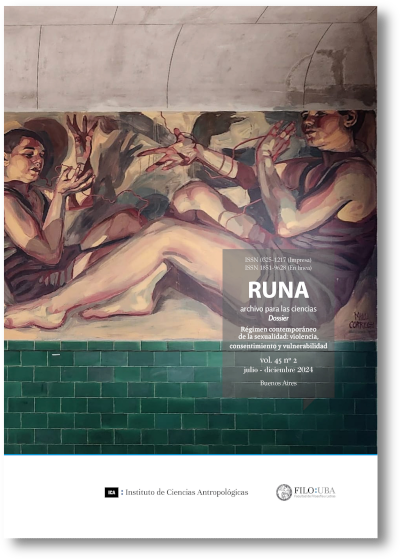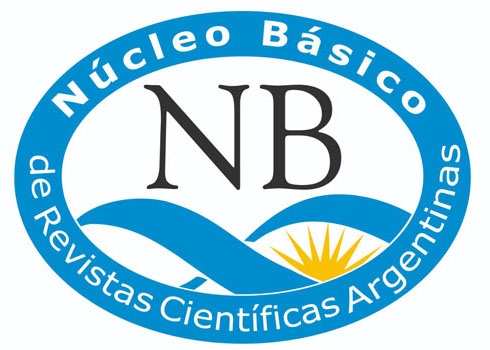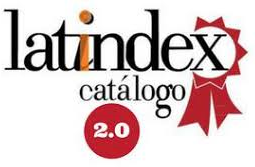First application of the protocol for the contextualization of institutionalized human remains in the Museum of Natural Sciences of the University of La Plata (Argentina)
Abstract
The aim of this work is to present the results of a study on human bone remains where the protocol developed in 2007 by the Anthropology Division of the Faculty of Natural Sciences and Museum of the University of La Plata was applied for the first time. This protocol is aimed at generating information that allows providing elements for the contextualization of human remains of unknown origin and their subsequent entry into the collection of the Anthropology Division. Through a multidisciplinary approach, it was learned that these remains correspond to an individual assigned to the older adult age group, female, on whom features of injuries associated with the oral cavity and joint degenerations were recorded. On the other hand, its maternal lineage corresponding to the D1g subclade was identified and a radiocarbon analysis carried out on these remains allowed us to obtain a date of 2420 14C years BP. This protocol demonstrates the possibility of contextualizing remains of unknown origin to incorporate them into the Museum’s collection.Downloads
References
Andrews, R. M., Kubacka, I., Chinnery, P. F., Lightowlers, R. N., Turnbull, D. M. y Howell, N. (1999). Reanalysis and revision of the Cambridge reference sequence for human mitochon-drial DNA. Nature Genetics, 23(2), 147.
Aranda, C., Barrientos, G. y Del Papa, M. C. (2014). Código deontológico para el estudio, conservación y gestión de restos humanos de poblaciones del pasado. Revista Argentina de Antropología Biológica, 16(2), 111-13. Recuperado de https://revistas.unlp.edu.ar/raab/article/view/797.
Arencibia, V., Crespo, C., García Guraieb, S., Russo, M. G., Dejean, C. B. y Goñi, R. (2019). Análisis genético poblacional de grupos cazadores recolectores del Holoceno tardío del Lago Salitroso (Santa Cruz, Argentina). Revista Argentina de Antropología Biológica, 21(2), 004. doi: https://doi.org/10.24215/18536387e004
Bandelt H. J., Forster, P. y Röhl, A. (1999). Median-joining networks for inferring intraspecific phylogenies. Mol. Biol. Evol., 16, 37-48.
Behrensmeyer, A. K. (1978). Taphonomic and Ecological Information from Bone Weathering. Paleobiology, 4, 150-162.
Binford, L. R. (1981). Bones: Ancient Men and Modern Myths. Nueva York, Academic Press.
Bodner, M., Perego, U. A., Huber, G., Fendt, L., Röck, A. W., Zimmermann, B., Olivieri, A., Gómez-Carballa, A., Lancioni, H., Angerhofer, N., Bobillo, M. C., Corach, D., Woodward, S. R., Salas, A., Achilli, A., Torroni, A., Bandelt, H. J. y Parson, W. (2012). Rapid coastal spread of First Americans: novel insights from South America’s Southern Cone mitochondrial genomes. Genome Research, 22(5), 811-820. https://doi.org/10.1101/gr.131722.111
Buckberry, J. L. y Chamberlain, A. T. (2002). Age estimation from the auricular surface of the ilium: a revised method. American Journal of Physical Anthropology: The Official Publication of the American Association of Physical Anthropologists, 119(3), 231-239.
Campillo, D. (2001). Introducción a la Paleopatología. Barcelona: Bellaterra.
Carnese, F., Mendisco, F. y Keyser, C. (2010). Paleogenetical study of pre-Columbian samples from Pampa Grande (Salta, Argentina). American Journal of Physical Anthropology, 141, 452-462.
Castro, J. C., Menéndez, L., Gordón, F., Fuchs, L., Di Bastiano, A., Del Papa, M., Muñe M. C. y Vázquez, R. (2009). Actualización del catálogo y de las condiciones de conservación de las colecciones de la División Antropología, Facultad de Ciencias Naturales y Museo, UNLP. I Congreso Iberoamericano y VIII Jornadas de Restauración y Conservación de Patrimonio. Soporte magnético. La Plata.
Crespo, C.M. (2011). Viajando con genes: una metodología molecular aplicada a interrogantes arqueológicos. Bariloche: IIDyPCa-UNRN-CONICET [Tesis].
Crespo, C. M., Russo, M. G., Hajduk, A., Lanata, J. L. y Dejean, C. B. (2017). Variabilidad mitocondrial en muestras precolombinas de la Patagonia argentina. Hacia una visión de su poblamiento desde el ADN antiguo. Revista Argentina de Antropología Biológica, 19(1), 1 – 21. https://doi.org/10.17139/raab.19.1.21
Crespo, C. M., Cardozo, D. G., Tessone, A., Vázquez, M., Kisielinski, C., Arencibia, V., Tackney, J., Zangrando, A. F. y Dejean, C. B. (2020). Distribution of maternal lineages in hunter-gatherer societies of the southern coast of Tierra del Fuego, Argentina. American Journal of Physical Anthropology, 173, e24107.
Dejean, C. B., Keyser, C., Avena, S., Dugoujon, J., Ludes, B., Crubezy, E. y Carnese, F. (2008). Análisis genético de muestras esqueletales provenientes del Canal de Beagle. Paper presentado al X Congreso Asociación Latinoamericana de Antropología Biológica, La Plata, Argentina.
Dejean, T., Valentini, A., Duparc, A., Pellier-Cuit, S., Pompanon, F., Taberlet, P. y Miaud, C. (2011). Persistence of environmental DNA in freshwater ecosystems. PLoS One, 6, e23398.
De la Fuente, C., Galimany, J., Kemp, B. M., Judd, K., Reyes, O. y Moraga, M. (2015). Ancient marine hunter-gatherers from Patagonia
and Tierra del Fuego: Diversity and differentiation using uniparentally inherited genetic markers. American Journal of Physical Anthropology, 158(4), 719-729. doi: https://doi.org/10.1002/ajpa.22815
de Saint Pierre, M., Bravi, C., Motti, J., Fuku, N., Tanaka, M., Llop, E., … Moraga, M. (2012). An alternative model for the early peopling of southern South America revealed by analyses of three mitochondrial DNA haplogroups. PLoS One, 7, e43486. doi: https://doi.org/10.1371/journal.pone.0043486
Del Papa, M., Vázquez, R., Mune, M. C. y Di Bastiano, A. (2010). Administración de las colecciones osteológicas en La División Antropología – FCNyM. Actas 1º Congreso Nacional de Museos Universitarios La Plata.
Del Papa, MC, Scabuzzo, C., Van Raap, MA., Bonilla, D. (2016). Nuevos análisis bioarqueológicos de la colección osteológica del sitio Paraná Ibicuy 1 (Delta Inferior del Río Paraná, Entre Ríos). Intersecciones en Antropología 17, 263-267.
Del Papa, MC, Pennini, VA, y Bonilla, D. (2018). Deformaciones artificiales de la bóveda del cráneo en el Delta del Paraná y cuenca inferior del Río Uruguay. Revista argentina de antropología biológica, 20(2), 1-12. https://dx.doi.org/10.17139/raab.2018.0020.02.04
Del Papa, MC; Scabuzzo, C.; Van Raap, M.A.; Bonilla, D. (2020). Re-análisis de las muestras bioarqueológicas provenientes de los sitios Palo Blanco y Los Talas (partido de Berisso, provincia de Buenos Aires)““.. Intersecciones en Antropología 21(1): 85-98.
Del Papa, M. C. y Pucciarelli, H. M. (2015). Administración de las colecciones de antropología biológica del Museo de La Plata. Revista Argentina de Antropología Biológica, 17(2), 1-5.
Del Papa, M. C. (2022). Las colecciones de la División Antropología del museo de La Plata. Revista do Museu de Arqueologia e Etnologia. 39: 44-53. San Pablo.
Farro, M. (2008). Historia de las colecciones en el Museo de la Plata, 1884 – 1906: naturalistas viajeros, coleccionistas y comerciantes de objetos de historia natural a fines del Siglo XIX (Tesis doctoral). Facultad de Ciencias Naturales y Museo. Universidad Nacional de La Plata, La Plata, Argentina.
García Guraieb, S., Goñi, R. y Tessone, A. (2015). Paleodemography of Late Holocene hunter-gatherers from Patagonia (Santa Cruz, Argentina): an approach using multiple archaeological and bioarchaeological indicators. Quaternary International, 356, 147-158. doi: 10.1016/j.quaint.2014.09.054
Ginther, C., Corach, D., Penacino, G. A., Rey, J. A., Carnese, F. R., Hutz, M. H., Anderson, A., Just, J., Salzano, F. M. y King, M. C. (1993). Genetic variation among the Mapuche Indians from the Patagonian region of Argentina: Mitochondrial DNA sequence variation and allele frequencies of several nuclear genes. En S. D. J. Pena, R. Chakraborty, J. T. Epplen y A. J. Jeffreys (Eds.). DNA Fingerprinting: State of the Science. Progress in Systems and Control Theory. Basel: Birkhäuser. doi: https://doi.org/10.1007/978-3-0348-8583-6_17
Hillson, S. W. (2000). Dental pathology. En M.A. Katzenberg y S.R. Saunders (Eds.). Biological anthropology of the human skeleton (pp. 249-286). Nueva York: Wiley-Liss. doi:10.2458/azu_js_rc.55.16783
Hogg, A. G., Heaton, T. J., Hua, Q., Palmer, J. G., Turney, C. S., Southon, J. y Wacker, L. (2020). SHCal20 Southern Hemisphere calibration, 0–55,000 years cal BP. Radiocarbon, 62(4), 759-778.
Horai, S., Kondo, R., Nakagawa-Hattori, Y., Hayashi, S., Sonoda, S. y Tajima, K. (1993). Peopling of the Americas, founded by four major lineages of mitochondrial DNA. Molecular Biology and Evolution, 10(1), 23-47.
Jiménez-Brobeil, S., Souich, P. y Al Oumaoui, I. (2009). Possible relationship of cranial traumatic injuries with violence in the south-east Iberian Peninsula from the Neolithic to the Bronze Age. American Journal of Physical Anthropology, 140, 465- 475. doi: 10.1002/ajpa.21089
Johnson, D. L. y Haynes, C.V. (1985). Camels as taphonomic agents. Quaternary Research, 24(3), 365-366.
Kumar, S., Stecher, G. y Tamura, K. (2016). MEGA7: molecular evolutionary genetics analysis version 7.0 for bigger datasets. Molecular biology and evolution, 33(7), 1870-1874.
Lovejoy, C. O., Meindl, R. S., Pryzbeck, T. R. y Mensforth, R. P. (1985). Chronological metamorphosis of the auricular surface of the ilium: a new method for the determination of adult skeletal age at death. American journal of physical anthropology, 68(1), 15-28.
Luna, L., Aranda, C. y Amorim Alves, A. (2017). Reflexiones sobre el relevamiento y análisis comparativo de patologías osteoarticulares en restos esqueletales humanos. Revista Argentina de Antropología Biológica, 19(1), 0-0.
Lyman, R. L. (1984). Bone density and differential survivorship of fossil classes. Journal of Anthropological Archaeology, 3, 259-299.
Lyman, R. y Fox, G. (1989). A critical evaluation of bone weathering as an indication of bone assemblage formation. Journal of Archaeological Science, 16, 293-317.
Lyman, R. (1994). Index. En Vertebrate Taphonomy (Cambridge Manuals in Archaeology) (pp. 517-524). Cambridge: Cambridge University Press.
Lyman, RL. y Fox, GL.(1989). A critical evaluation of bone weathering as an indication of bone assemblage formation. Journal of Archaeological Science, 16, 293-317
Mondini, M. 2003 Formación del registro arqueofaunístico en abrigos rocosos de la Puna argentina. Tafonomía de carnívoros. Tesis Doctoral. Universidad de Buenos Aires, Buenos Aires.
Moraga, M., de Saint Pierre, M., Torres, F. y Ríos, J. (2010). Vínculos de parentesco por vía materna entre los últimos descendientes de la etnia Kawesqar y algunos entierros en los canales patagónicos: evidencia desde el estudio de linajes mitocondriales. Magallania, 38(2), 103-114.
Morosi, J. (2004). Los creadores del Edificio del Museo de La Plata y su obra. La Plata: Fundación Museo de La Plata LINTA CIC.
Motti, J. M. B., Winingear, S., Valenzuela, L. O., Nieves-Colón, M. A., Harkins, K. M., García Laborde, P., Bravi, C. M., Guichón, R. A. y Stone, A. C. (2020). Identification of the geographic origins of people buried in the cemetery of the Salesian Mission of Tierra del Fuego through the analyses of mtDNA and stable isotopes. Journal of Archaeological Science: Reports, 33, 102559.
Parolin, M. L., Galimay, J., Gómez Otero, J., Dahinten, S., Millán, A. G. y Moraga, M. (2019). Primeras secuencias mitocondriales de la región control completa en muestras humanas del Holoceno tardío de la costa norte y centro de Patagonia, argentina. En J. Gómez Otero, A. Svoboda y A. Banegas (Eds.). Arqueología de la Patagonia: el pasado en las arenas (pp. 469-480). Puerto Madryn: CNAA.
Polzin, T. y Daneschmand, S. V. (2003). On Steiner trees and minimum spanning trees in hypergraphs. Operations Research Letters., 31, 12-20.
Postillone, M. B., Serna, A., Dejean, C. B. y Prates, L. (2020a). Ancestría materna de los individuos del sitio Chimpay (Río Negro) e implicancias para la interpretación de un contexto mortuorio del siglo XIX. Anales de Arqueología y Etnología, 75(2), 213-227.
Postillone, M., Martinez, G., Flensborg, G. y Dejean, C. (2020b). First analysis of mitochondrial lineages from the Eastern Pampa-Patagonia transition during the Final Late Holocene. American Journal of Physical Anthropology, 171, 659-670.
Raghavan, M., Steinrücken, M., Harris, K., Schiffels, S., Rasmussen, S., De Giorgio, M. Albrechtsen, A., Valdiosera, … Willerslev, E. (2015). Genomic evidence for the Pleistocene and recent population history of Native Americans. Science, 349, 6250.
Resnick, D. (1985). Degenerative diseases of the vertebral column. Radiology, 156 (1), 3-14. https://doi.org/10.1148/radiology.156.1.3923556 DOI: https://doi.org/10.1148/radiology.156.1.3923556
Ricardi, A. C. (2014). Paleontología al servicio de la geología y de la sociedad. Ciencia e Investigación. 2 (1):79 – 92.
Sardi, M. y Del Papa, M. (2022). Escrito en los huesos y el papel. Una revisión de las colecciones antropológicas del Museo de La Plata. Revista del Museo de Antropología, 15(1), 179-192.
Smith, B. H. (1984). Patterns of molar wear in hunter-gatherers and agriculturalist. American Journal of Physical Anthropology, 69, 39-56. doi: 10.1002/ajpa.1330630107
Üstündağ, H. (2009). Schmorl’s nodes in a post-medieval skeletal sample from Klostermarienberg, Austria. International Journals of Osteoarchaeology, 19, 695-710. doi:10.1002/oa.993
van Oven, M. y Kayser, M. (2009). Updated comprehensive phylogenetic tree of global human mitochondrial DNA variation. Human Mutation., 30(2), E386-94. doi: 10.1002/humu.20921. PMID: 18853457.
Villa, P. y Mahieu, E. (1991). Breaskage patterns of human long bones. Journal of Human Evolution, 20, 1-22.
Waldron, T. (2009). Palaeopathology. New York, Estados Unidos: Cambridge University Press. doi:10.1017/CBO9780511812569
Weiss, E. (2006). Osteoarthritis and body mass. Journal of Archaeological Science, 33, 690-695. doi: 10.1016/j.jas.2005.10.003
Weston, D. (2012). Nonspecific infection in paleopathology: interpreting periosteal reactions. En: A. Grauer (Ed.), A Companion to Paleopathology (pp. 492-512). John Wiley & Sons, Ltd.
Weissensteiner, H., Pacher, D., Kloss-Brandstätter, A., Forer, L., Specht, G., Bandelt, H. J. y Schönherr, S. (2016). HaploGrep 2: mitochondrial haplogroup classification in the era of high-throughput sequencing. Nucleic acids research, 44(W1), W58-W63.
Copyright (c) 2024 Mariano Del Papa, Cristian Crespo, Cristina Dejean, Marcos Plischuk

This work is licensed under a Creative Commons Attribution 4.0 International License.

Runa, archivos para las ciencias is a publication of the Instituto de Ciencias Antropológicas, Facultad de Filosofía y Letras, Universidad de Buenos Aires and is distributed under a Creative Commons Attribution 4.0 International License.
Runa maintains its commitment to the policies of Open Access to scientific information, considering that both scientific publications and publicly funded research should circulate on the Internet freely, free of charge and without restrictions.
The contents and opinions expressed in published articles are the sole responsibility of their authors.



















